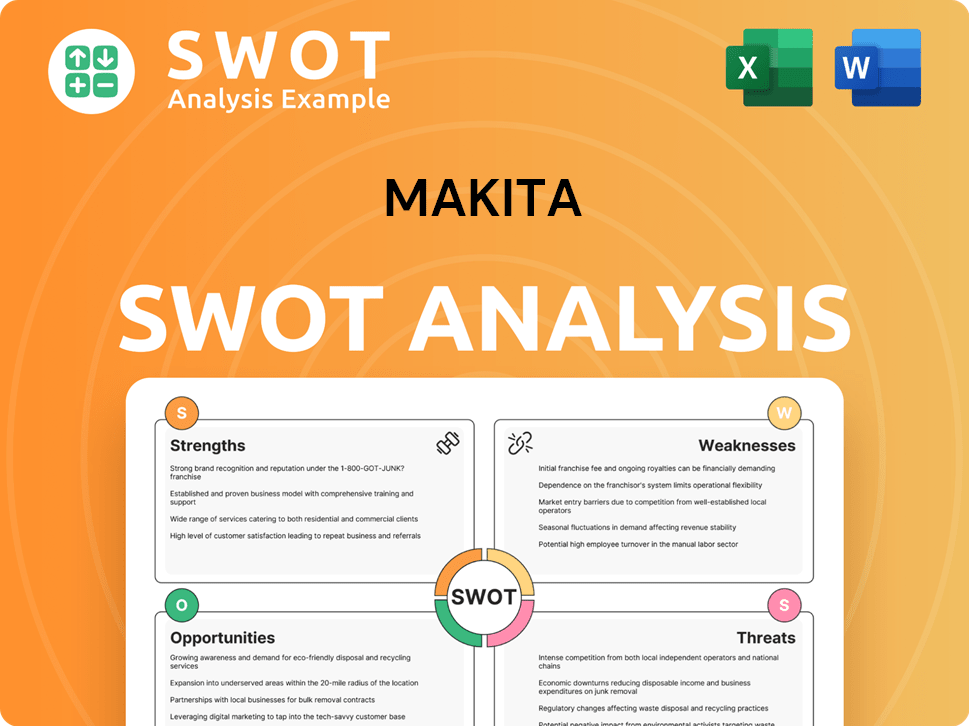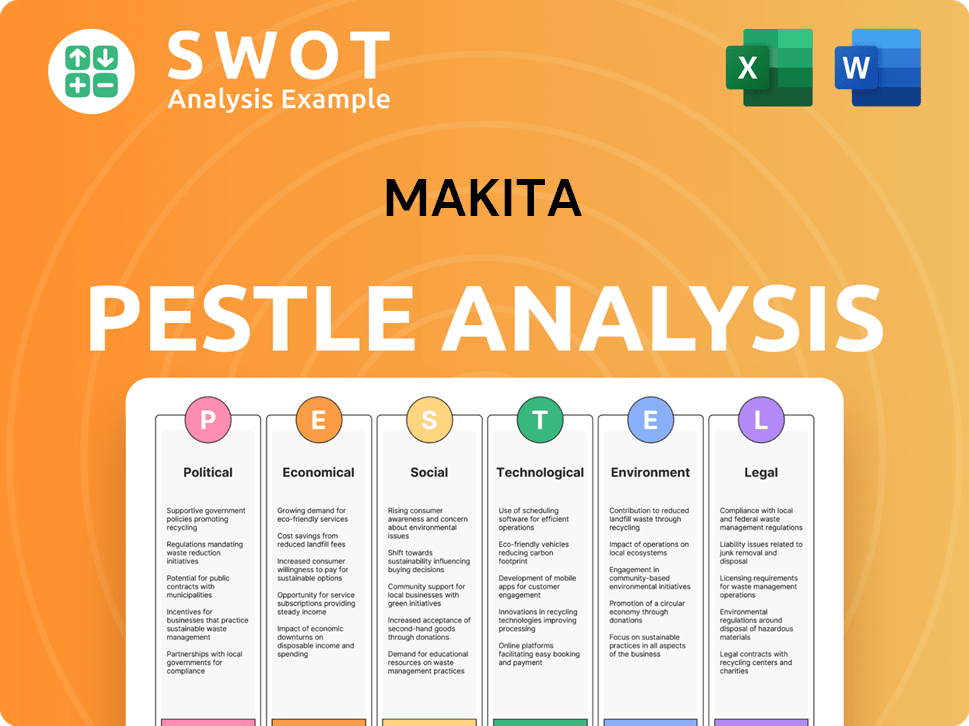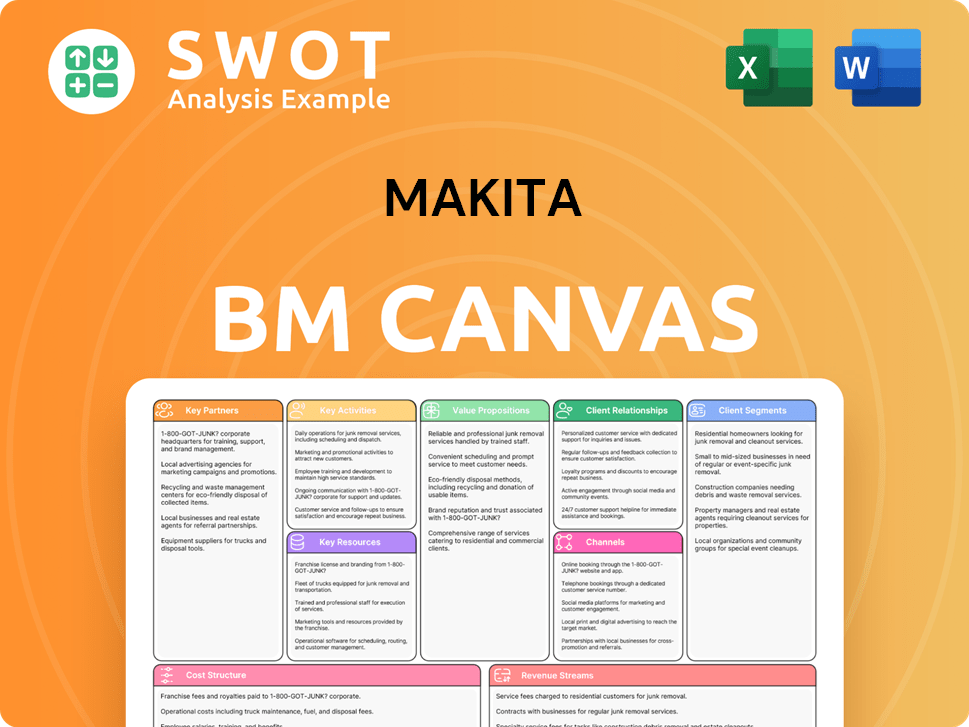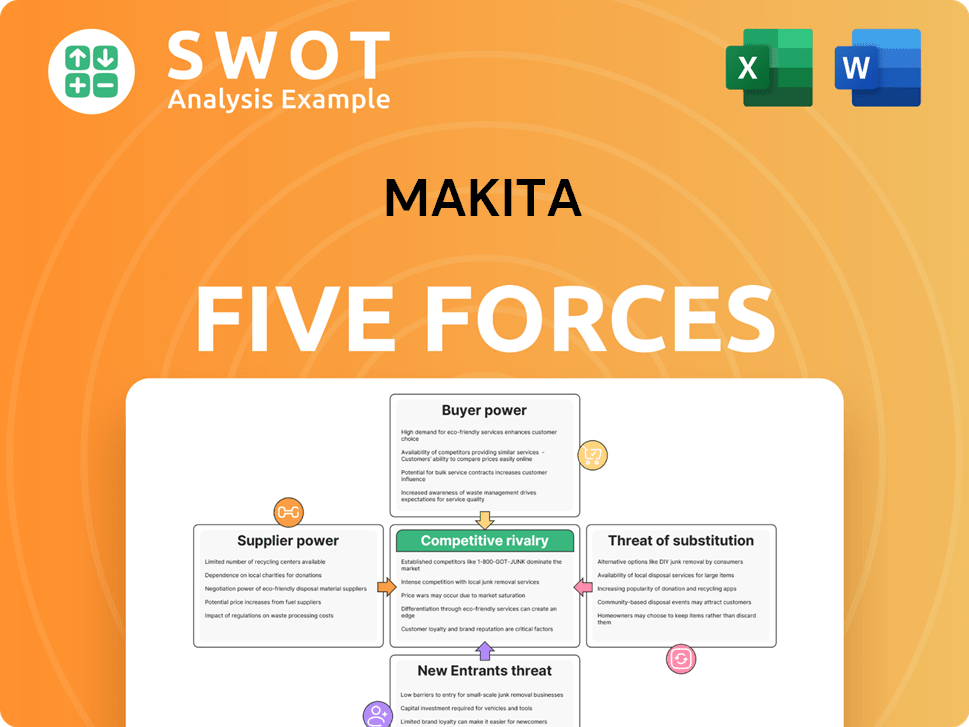Makita Bundle
Can Makita Maintain Its Edge in the Power Tool Wars?
The power tool industry is a battleground of innovation and fierce competition, with global players constantly vying for market dominance. Makita Corporation, a name synonymous with quality and reliability, has long been a key player, but how does it stack up against its rivals? Founded in 1915, Makita has evolved from a local electrical shop into a multinational powerhouse.

To truly understand Makita's position, we must dissect its Makita SWOT Analysis, its competitors, and the broader trends shaping the cordless tool market. This deep dive into the Makita competitive landscape will reveal its strengths, weaknesses, and strategies for success in a dynamic industry. Understanding Makita's market share and brand positioning is crucial for anyone looking to invest or strategize within the power tool industry.
Where Does Makita’ Stand in the Current Market?
Makita Corporation holds a significant position in the global power tool market, consistently ranking among the top manufacturers. The company is recognized as a key player, often competing for market leadership, especially in the cordless tool segment. Its product range includes a wide array of cordless and corded power tools, catering to both professional contractors and demanding DIY users.
Makita's core operations revolve around the design, manufacturing, and distribution of power tools and related accessories. The company's value proposition centers on providing high-quality, durable, and innovative tools that enhance efficiency and productivity. This focus has allowed it to establish a strong brand reputation, particularly in the professional market, where its tools are often viewed as premium products.
The company's focus on innovation, particularly in battery technology, has enabled it to shift its positioning towards high-performance cordless solutions, appealing to professionals seeking mobility and efficiency. This strategic shift has been instrumental in capturing a substantial share in the professional segment. For a deeper dive into how the company approaches its market, consider exploring the Marketing Strategy of Makita.
Makita consistently ranks among the top power tool manufacturers globally. While exact market share figures for 2024-2025 fluctuate, the company typically holds a top-three or top-four position. This strong market presence is a testament to its brand recognition and product quality.
Makita boasts a strong global presence with manufacturing facilities and sales networks across Asia, Europe, North America, and South America. The company has strategically expanded into emerging markets while maintaining robust sales in established regions. This broad geographic footprint supports its overall market position.
Makita offers a comprehensive range of power tools, including cordless and corded options. The company emphasizes innovation, particularly in battery technology, which has driven its shift towards high-performance cordless solutions. This focus on innovation helps Makita maintain a competitive edge.
Makita has demonstrated consistent financial performance. For the fiscal year ended March 31, 2024, net sales were reported at JPY 854.8 billion (approximately USD 5.5 billion). This financial stability supports its ability to invest in research, development, and marketing, further strengthening its market position.
Makita's strengths include its strong brand reputation, innovative product offerings, and global presence. However, the company faces intense competition, particularly in mature markets like North America and Europe. Aggressive pricing and product innovation from rivals constantly challenge its position in the power tool industry.
- Strong brand recognition and customer loyalty.
- Focus on cordless technology and battery innovation.
- Extensive global distribution network.
- Intense competition from established and emerging players.
Makita SWOT Analysis
- Complete SWOT Breakdown
- Fully Customizable
- Editable in Excel & Word
- Professional Formatting
- Investor-Ready Format

Who Are the Main Competitors Challenging Makita?
The Growth Strategy of Makita involves navigating a complex competitive landscape. Understanding the Makita competitive landscape is crucial for assessing its market position and future prospects. This analysis focuses on key rivals and the dynamics shaping the power tool industry.
Makita's market share is constantly challenged by both direct and indirect competitors. The power tool industry is characterized by continuous innovation, aggressive marketing, and evolving consumer preferences. This environment necessitates a thorough understanding of the strengths and strategies of key players.
Makita competitors include a mix of global power tool manufacturers and emerging brands. These competitors employ diverse strategies, ranging from product innovation and aggressive pricing to expanding distribution networks and targeting specific market segments. The competitive environment is further shaped by mergers, acquisitions, and the rise of e-commerce.
Direct competitors are those that offer similar products and target the same customer base as Makita. They compete head-to-head in the power tool market. These companies often have established brand recognition and extensive distribution networks.
Stanley Black & Decker is a major player in the power tool industry. It competes with its DeWalt, Black+Decker, and Stanley brands. DeWalt is a direct competitor to Makita, especially in the professional-grade cordless and corded power tool markets.
Bosch Power Tools is another significant competitor globally. They are known for their presence in both professional and DIY segments. Bosch offers a wide array of tools and accessories, focusing on precision and technology.
Milwaukee Tool, owned by Techtronic Industries Co. Ltd. (TTI), has rapidly gained market share. They are particularly aggressive in the professional cordless tool segment. Milwaukee has engaged in high-profile competition with Makita and DeWalt.
Indirect competitors offer products that serve similar purposes or target different segments of the market. They may not directly compete with Makita's core product lines but still impact its market position. These competitors can include specialized tool manufacturers and private-label brands.
These companies focus on specific niches such as outdoor power equipment or pneumatic tools. They may not have the same breadth of product offerings as Makita but can be strong competitors in their specialized areas.
Several factors influence the power tool industry analysis and the competitive landscape. These include technological advancements, changing consumer preferences, and the impact of e-commerce. The industry is also affected by mergers and acquisitions, which reshape the competitive dynamics.
- Product Innovation: Continuous introduction of new features and technologies, especially in cordless tools.
- Pricing Strategies: Competitive pricing to attract customers and maintain market share.
- Distribution Channels: Expanding and optimizing distribution networks to reach a wider audience.
- Marketing and Branding: Building strong brand recognition and customer loyalty.
- E-commerce: Leveraging online platforms to increase sales and reach new customers.
Makita PESTLE Analysis
- Covers All 6 PESTLE Categories
- No Research Needed – Save Hours of Work
- Built by Experts, Trusted by Consultants
- Instant Download, Ready to Use
- 100% Editable, Fully Customizable

What Gives Makita a Competitive Edge Over Its Rivals?
The Makita competitive landscape is shaped by its strong brand reputation, built over more than a century. The company's focus on quality and durability has cultivated significant customer loyalty among professionals globally. This has allowed it to maintain a strong position within the power tool industry analysis.
Makita's strategic moves, particularly in battery technology, have been crucial. Early adoption and continuous investment in platforms like LXT and XGT have created a comprehensive ecosystem. This ecosystem provides users with flexibility and cost savings, creating a significant barrier to exit, and impacting the cordless tool market.
Makita's global distribution network is another key element. A widespread presence of distributors, dealers, and service centers ensures product availability and support, crucial for professional users. This is a vital aspect of understanding Makita's global market presence.
Makita's long-standing reputation for quality and durability is a cornerstone of its competitive advantage. This has fostered trust among professionals worldwide.
Continuous innovation in battery technology, especially with the LXT and XGT platforms, provides a significant edge. The interchangeable battery system enhances user convenience and cost-effectiveness.
A robust and widespread distribution network ensures product availability and support. This is crucial for serving the needs of professional users.
Vertically integrated manufacturing and strong supply chain management contribute to operational efficiency. This allows for competitive pricing while maintaining quality standards.
Makita's competitive advantages are multi-faceted, including brand recognition and technological innovation. These factors contribute to its strong position within the Makita competitive landscape. While competitors also invest in R&D, Makita's established brand and relationships provide a sustainable edge.
- Brand Reputation: A century of quality and trust.
- Battery Platform: LXT and XGT ecosystems for user convenience.
- Distribution: Extensive global network for product availability.
- Innovation: Continuous R&D in power tool technology.
Makita Business Model Canvas
- Complete 9-Block Business Model Canvas
- Effortlessly Communicate Your Business Strategy
- Investor-Ready BMC Format
- 100% Editable and Customizable
- Clear and Structured Layout

What Industry Trends Are Reshaping Makita’s Competitive Landscape?
The power tool industry is currently experiencing significant shifts, presenting both challenges and opportunities for companies like Makita. The increasing demand for cordless tools, driven by advancements in battery technology, is a major trend. Additionally, the focus on sustainability and the integration of smart technologies are reshaping the competitive landscape. Understanding these trends is crucial for assessing the Growth Strategy of Makita and its competitors.
Several factors could impact Makita's future. These include the intensity of competition from emerging markets, potential economic downturns, and supply chain disruptions. Conversely, opportunities exist in expanding into emerging markets, growing the DIY segment, and forming strategic partnerships. The ability to adapt to these changes will be key to maintaining and growing its market position.
The power tool industry is seeing a strong shift towards cordless technology, driven by improved battery performance and user convenience. Sustainability is becoming increasingly important, with a growing demand for battery-powered tools and environmentally friendly manufacturing processes. Technological advancements, such as the integration of smart features and IoT connectivity, are also emerging as key trends.
Aggressive pricing from competitors, particularly those from Asian markets, poses a significant challenge. Economic downturns impacting construction and manufacturing sectors could reduce demand. Supply chain disruptions, as experienced in recent years, continue to be a concern. Cybersecurity risks and the need for continuous software development are also challenges.
Emerging markets with growing infrastructure development offer significant growth potential. The expansion of the DIY segment, fueled by online content and accessibility, creates opportunities. Strategic partnerships can help enter new niches and expand technological capabilities. Regulatory changes favoring electric tools will benefit cordless offerings.
Makita should focus on its cordless ecosystem, sustainable products, and smart tool integration. Expanding its outdoor power equipment line and investing in advanced robotics are crucial. Exploring new service models related to tool usage data is also important. These strategies will help Makita remain competitive and capture future growth.
To thrive in the evolving power tool industry, Makita must focus on several key areas. This includes expanding its product offerings and improving its technological capabilities.
- Cordless Innovation: Continue to invest in and expand the LXT and XGT cordless platforms, focusing on battery life, power, and tool versatility.
- Sustainable Products: Develop and promote battery-powered outdoor power equipment to meet the growing demand for environmentally friendly solutions.
- Smart Tool Integration: Integrate smart features, IoT connectivity, and AI for predictive maintenance and enhanced user experience.
- Strategic Partnerships: Explore partnerships to enter new markets or expand technological capabilities, such as collaborations in battery technology or smart tool development.
Makita Porter's Five Forces Analysis
- Covers All 5 Competitive Forces in Detail
- Structured for Consultants, Students, and Founders
- 100% Editable in Microsoft Word & Excel
- Instant Digital Download – Use Immediately
- Compatible with Mac & PC – Fully Unlocked

Related Blogs
- What are Mission Vision & Core Values of Makita Company?
- What is Growth Strategy and Future Prospects of Makita Company?
- How Does Makita Company Work?
- What is Sales and Marketing Strategy of Makita Company?
- What is Brief History of Makita Company?
- Who Owns Makita Company?
- What is Customer Demographics and Target Market of Makita Company?
Disclaimer
All information, articles, and product details provided on this website are for general informational and educational purposes only. We do not claim any ownership over, nor do we intend to infringe upon, any trademarks, copyrights, logos, brand names, or other intellectual property mentioned or depicted on this site. Such intellectual property remains the property of its respective owners, and any references here are made solely for identification or informational purposes, without implying any affiliation, endorsement, or partnership.
We make no representations or warranties, express or implied, regarding the accuracy, completeness, or suitability of any content or products presented. Nothing on this website should be construed as legal, tax, investment, financial, medical, or other professional advice. In addition, no part of this site—including articles or product references—constitutes a solicitation, recommendation, endorsement, advertisement, or offer to buy or sell any securities, franchises, or other financial instruments, particularly in jurisdictions where such activity would be unlawful.
All content is of a general nature and may not address the specific circumstances of any individual or entity. It is not a substitute for professional advice or services. Any actions you take based on the information provided here are strictly at your own risk. You accept full responsibility for any decisions or outcomes arising from your use of this website and agree to release us from any liability in connection with your use of, or reliance upon, the content or products found herein.